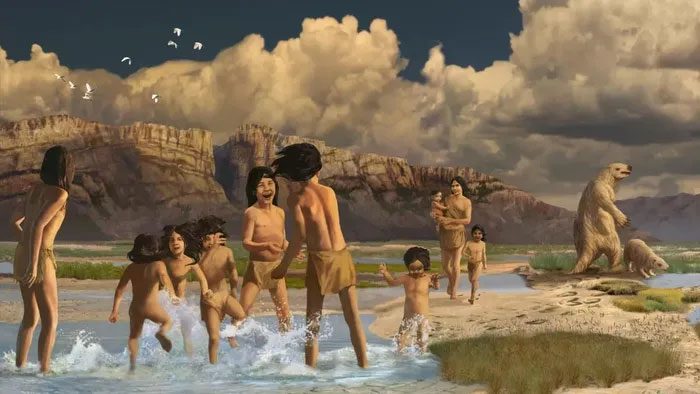Few things are more appealing to children than a puddle of mud. Children race and dash across a wet trail, leaving their footprints on a dry lakebed. These footprints have been preserved to this day, providing evidence of prehistoric humans.

Illustration of children from the last Ice Age splashing in a puddle on a trail in what is now New Mexico, USA
More than 11,000 years ago, children walking with their families through what is now White Sands National Park in New Mexico discovered something to play with: puddles formed from the footprints of a giant ground sloth.
This discovery suggests that children living in North America during the Pleistocene era (2.6 million to 11,700 years ago) enjoyed playing in water. Matthew Bennett, a professor of geography and environmental science at Bournemouth University in the UK, who is studying this trail, stated: “All children love to play in puddles, that’s basically it.”
Bennett has visited White Sands more than a dozen times over the past five years, locating and analyzing footprints left by Ice Age humans and animals. He and his colleagues have made several notable discoveries, including human footprints dated between 21,000 and 23,000 years ago, the earliest clear evidence of humans in the Americas.
Bennett plans to write about this discovery in the coming months as a methodological paper, to help scientists studying similar trails determine how many people were present and the ages of those individuals when they were created. For example, the traces that Bennett analyzed are not an exact representation of children’s feet, as the muddy terrain distorts them, but Bennett can compare the preserved footprints with modern growth data to infer the ages of the children.
He found that there are over 30 intertwined footprints on this trail that could belong to children aged 5 to 8 years.
The giant ground sloth, possibly Nothrotheriops, left the area after walking through on all fours. Each footprint of the sloth on the massive ground measures nearly 40 cm long. The shallow prints are about 3 cm deep, but they seem deep enough to fill with water and intrigue the children.
It is difficult to date the footprints without detailed stratigraphy—or studying the rock layers—of the site and without finding any organic materials, such as radiocarbon. However, based on the discovery of 23,000-year-old footprints and the fact that ground sloths went extinct about 11,000 years ago, these children’s footprints were likely made between 23,000 and 11,000 years ago.





















































